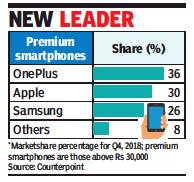OnePlus and India
This is a collection of articles archived for the excellence of their content. |
Sales in India
2018: no. 1
Avik Das1, How OnePlus won smartphone mkt, February 5, 2019: The Times of India

From: Avik Das1, How OnePlus won smartphone mkt, February 5, 2019: The Times of India
When OnePlus launched its first mobile phone nearly five years ago, its main target market was the US and Europe. India was nowhere on its radar. The Chinese company wanted to be an online brand and operate in the premium smartphone market. But in India at the time, e-commerce was in a nascent stage, and the premium phone pie was small.
What happened soon after surprised company executives. “Within five months, we noticed that a lot of users from India were buying the phone on Amazon’s global website using a US address, and then auto-forwarding it to India through Aramex, a Dubai-based logistics company. They were undeterred by the customs duty, which could increase the cost by Rs 5,000,” recalls Vikas Agarwal, general manager for OnePlus in India.
A closer monitoring of website traffic trends showed that India was among the top seven countries in sales, though the company was not selling in India. “That’s when we decided to launch here,” says Agarwal, who was the first employee for OnePlus in India when he joined in October 2014. The first set of phones were introduced in December that year.
Four years hence, India is OnePlus’s single largest market, accounting for 33%, or $466 million, of the company’s total revenue of $1.4 billion in 2017. China is the second biggest market, while Europe and America make up the rest. In the last few quarters, OnePlus has also become the biggest premium smartphone (those above Rs 30,000) player in India, overtaking Samsung and Apple. And all of this has come from just one new product that it launches every year.
“What has clicked is the positioning, the focus on the premium segment. They were at the right place at the right time. When they entered, the premium market was just 1-2%, which has now grown to 5-6%. With their strategy of one device per year and attractive pricing, they positioned the brand really well,” Tarun Pathak, associate director at Counterpoint Research, said.
What has worked most for the company is the pricing. In this extremely price-sensitive market, OnePlus is seen as great value for money. Its 6T model sells for about Rs 38,000 on Amazon, significantly lower than Samsung’s Galaxy S9 at Rs 61,000 and Apple’s iPhone X at about Rs 85,000.
Another strategy that has worked well for the Shenzenbased company is the word of mouth it gets, and its social media strategy to target a new consumer base. Not only are loyal OnePlus consumers upgrading, but the company is also attracting customers who previously used an Apple or a Samsung phone. “Out of the new purchases, we have seen about 20% people from Samsung and close to 17% from Apple. This movement has started to scale now,” says Agarwal.
Pete Lau, founder and chief executive of OnePlus, says the secret sauce to the company’s success in India is “our total focus on products”.
See also
OnePlus and India